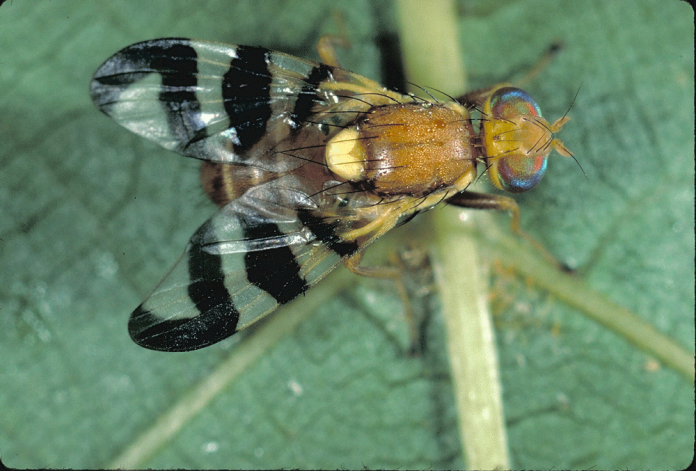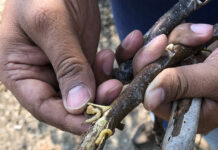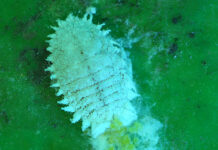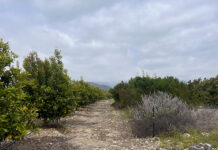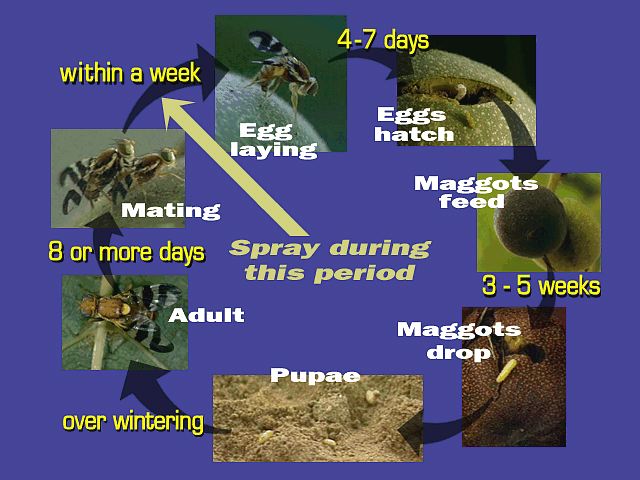
Walnut husk fly poses particular challenges for developing a truly integrated pest management (IPM) program due to the nature of its life cycle (one generation per year with a long emergence period) and lack of natural enemies. As a result, best practices for management rely heavily on monitoring and insecticide treatments. Precise timing based on monitoring method and rotation of chemistries to minimize resistance risk are keys to successful long-term control of this pest.
Susceptible Varieties
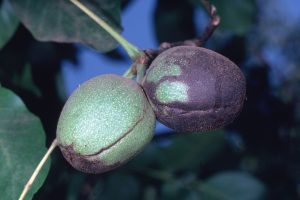
Walnut husk fly (WHF) damage earlier in the season causes shriveled and darkened kernels, increased mold growth, and lower yields. Later season infestations result in little kernel damage, but may stain the shells and make husk removal difficult. All commercial English walnut cultivars are susceptible to WHF infestation, although they differ in their relative degrees of susceptibility and thus damage potential. In general, Hartley, Tulare, Franquette, Payne, and Serr are considered more susceptible, with Howard, Ashley, Chico, and Chandler exhibiting less susceptibility (in order as listed). However, even less susceptible varieties can be damaged by high populations of WHF. Black walnut is also a preferred host, therefore proximity to black walnut can significantly increase WHF pressure in commercial Englishwalnut orchards.
The varietal differences in susceptibility have been correlated to fruit characteristics including husk color, husk hardness, fruit size, trichome density, and plant volatile profiles, in addition to temporal factors (i.e., more severe earlier season damage may be more evident in earlier-leafing cultivars). Current research led by Dr. Steven Seybold (United States Department of Agriculture (USDA) Chemical Ecology Entomologist) is characterizing the plant volatile profiles associated with differences in varietal susceptibility, which may lead to improvements in monitoring and control products, as well as inform plant breeding approaches for genetic resistance or tolerance to WHF infestation.
WHF Life Cycle
The life cycle and basic biology of walnut husk fly is fairly well understood (Figure 1). There is a single generation per year, with adult emergence historically beginning in early to mid-June and lasting through September in the Central Valley. In coastal areas, and recently some inland valley locations, emergence can be detected earlier, in mid- to late-May. Peak emergence is generally observed July through mid-August in most locations. Females must mate and develop eggs prior to the initiation of oviposition into the walnut husk, a period which averages approximately two weeks after emergence. Once eggs are laid, maggots emerge within approximately four to seven days, and feed on the husk for a typical period of three to five weeks. After this period, mature maggots drop to the ground and pupate in the soil. Most adults emerge the following year, but a portion of the population may remain in the soil as pupae for two or more years before emerging as adults.

Extended Emergence Period
The extended emergence period of the single generation of WHF, and significant differences in the timing of initial emergence, peak emergence, and end of the flight based on location, year, and other factors, have been the subject of much research. As opposed to some other key pests (e.g., codling moth), there is not yet a validated phenology or degree-day model available for growers and pest control advisors (PCA) to readily adopt to predict key WHF development and adult activity timings. Two recent publications out of University of California (UC) Berkeley (Emery and Mills 2019a, 2019b) investigated the effects of temperature and other environmental parameters on walnut husk fly development and timing. One study evaluated 18 years of historical trap catch data from 49 walnut orchards spanning the Central Valley to determine which factors most influence emergence timing and thermal requirements for development (degree days to emergence), with the goal of developing a phenology model that can be used to predict initial and peak emergence. Some of the factors evaluated included latitude, walnut cultivar, orchard age, winter precipitation, winter chill, and degree-day accumulation. While this model requires refinement for adoption by orchard practitioners (growers and PCAs), it represents a great step forward in improving our understanding of WHF developmental requirements to aid in our IPM program development.
Biological Control Agents
Biological control agents for walnut husk fly in California walnuts are virtually non-existent. The pest in general appears to have few natural enemies. Some reports from the state of Washington indicate that a predatory mite and anthocorid bug species have been observed feeding on WHF eggs, and some spiders and ants may feed on larvae and adults. In addition, chickens and other birds are said to be among the natural enemies of WHF. However, any naturally-occurring WHF biological control agents that may be found in walnut orchards are not known to provide any significant level of population reduction. Other mortali
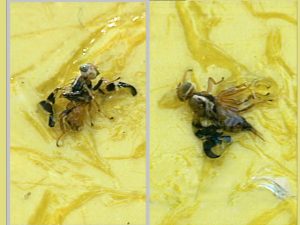
ty factors, particularly those that may impact the overwintering pupal stage in the soil (e.g., intentionally augmenting soil moisture, various cultivation practices, effects or augmentation of insect-parasitic nematodes or other microorganism populations, soil insecticide applications) have been explored to some degree with no specific recommendations or guidelines emerging as a result.
WHF Management Guidelines
In spite of some of these challenges for WHF management, guidelines regarding treatmenttiming and options are available, and when employed properly tend to provide adequate control of WHF in many situations (albeit with more insecticide intervention than may be desirable or sustainable in the long-term). Because WHF activity and population abundance can vary significantly from orchard to orchard (even those in very close proximity), site-specific monitoring is necessary to get the most effective results from insecticide applications.
Monitoring
Monitoring should begin earlier than the June 15 historical guideline (no later than June 1 in the Central Valley is the more recent recommendation). Some reports of late May catches in 2016 further support the “earlier-is-better” practice—there is little harm in counting zeroes for a few weeks. Yellow sticky card traps baited with ammonium carbonate lures should be hun
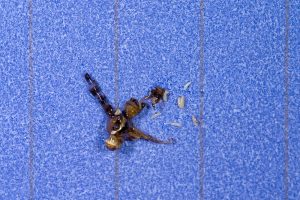
g high in the canopy (minimum 2 per 10 acres) in dense foliage on the north side of trees and checked two to three times per week. Each orchard should be monitored individually for WHF activity to best determine if and when to treat. A summary article regarding the efficacy of available traps/lures for WHF monitoring was published in 2014 (http://www.sacvalleyorchards.com/walnuts/insects-miteswalnuts/walnut-husk-fly-trap-and-low-volume-spray-study/).
Treatment Timing
Treatment timing can be based on one of three monitoring methods (the first two have typically been most effective).
- Detection of eggs in trapped females. This is a simple process that requires slightly more time than counting overall trap catches and can increase the efficacy of treatments by timing applications to specifically target female oviposition activity. Females can be distinguished from males by the shape of the abdomen (pointier in females) and color of the front leg (female leg is entirely yellow, male leg is black close to the body, Photo 3). After females are identified, gently squishing the female abdomen will squeeze out eggs if they are present (Photo 4). Eggs resemble small grains of rice. Previous guidelines indicated that the treatment window is one week after egg detection. However, recent modifications suggest that treatments should be considered as soon as the first female with eggs is found because in practice there is often a lag time in getting the treatments out, and trap checks (even two to three checks per week) may not be frequent enough to represent initial egg development in the female population. Therefore, planning to treat as soon as possible after eggs are detected may be the best option to minimize infestation and damage. [Note that this is the preferred method for timing treatments unless using GF-120® alone; see below].
- Overall trap catches. For low to moderate populations, consider treatment when a sharp increase occurs in trap counts. In high pressure orchards or if using GF-120® alone, treatment should be considered when any flies are detected rather than waiting for a sharp increase in catches.
- Stings on nuts. This is the least preferred method, as damage has already occurred. However, examining nuts for stings (Photo 5) can provide indication of efficacy of your management program when using one of the first two methods. If using this method to time treatments, consider treating when the first sting is observed using full cover neonicotinoid materials that have some ovicidal activity mixed with an adulticide.
Continued monitoring throughout the season is crucial. Short-residual insecticides plus bait will generally kill WHF for seven to ten days. Target subsequent applications at two- to four-week intervals based on the efficacy of the previous spray and trap catches. Clean traps the day after application and check three to four days later. If the number of flies drops to near zero, the spraywas highly effective and a longer treatment interval may be used. If post-treatment catches increase or eggs are detected in trapped females, and the residual period of the previous treatment has elapsed, additional treatments may be required if harvest is more than three weeks away.
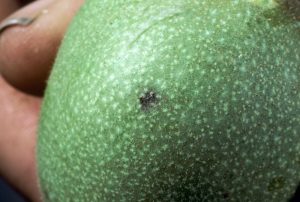
There are several materials effective against WHF, both for conventional and organic orchards. All materials aside from GF-120® (which contains its own bait) should be applied with a bait (e.g., Nu-Lure®, molasses, etc.). However, very high population orchards with extensive previous damage may require full coverage sprays (no bait needed) to achieve adequate suppression. Keep in mind that rotation of chemistries (based on the Insecticide Resistance Action Committee (IRAC) mode of action classification) is critical to minimize resistance development for pests that are treated multiple times each season. Proper aphid management can also help limit movement of WHF within and between orchards by reducing honeydew accumulation (a food source for adult WHF).
The UC IPM Pest Management Guidelines (ipm.ucanr.edu/PMG/r881301211.html) lists insecticides, baits, and rates for WHF. A summary of efficacy data for selected materials (updated September 2016) are summarized at (www.sacvalleyorchards.com/walnuts/insects-mites-walnuts/walnut-husk-fly-biology-monitoring-and-spray-timing/).
Referenced articles:
Emery, S. A. and N. J. Mills. 2019a. Effects of temperature and other environmental factors on the post-diapause development of walnut husk fly, Rhagoletis completa (Diptera: Tephritidae). Physiological Entomology 44: 33-42.
Emery, S. A. and N. J. Mills. 2019b. Sources of variation in the adult flight of walnut husk fly (Diptera: Tephritidae): a phenology model for California walnut orchards. Environmental Entomology 48: 234-244.











